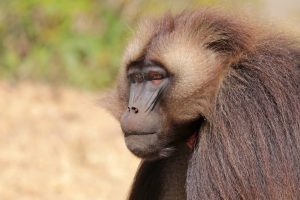Gelada Baboon
 Scientific Name : Theropithecus gelada
Scientific Name : Theropithecus gelada- IUCN Status : Least Concern
- It is sometimes called the bleeding-heart monkey or the gelada baboon, is a species of Old World monkey found only in the Ethiopian Highlands, living at elevations of 1,800–4,400 m (5,900–14,400 ft) above sea level.
- It is the only living member of the genus Theropithecus, a name derived from the Greek root words for “beast-ape”.
- The gelada has a complex multilevel social structure.
- Reproductive units and male units are the two basic groupings.
- The gelada is large and robust and it is covered with buff to dark brown, coarse hair and has a dark face with pale eyelids.
- The gelada has a hairless face with a short muzzle that looks more similar to a chimpanzee’s than a baboon’s.
- It can also be physically distinguished from a baboon by the bright patch of skin on its chest.
- The gelada has several adaptations for its terrestrial and graminivorous (grass-eating) lifestyle.
- It has small, sturdy fingers adapted for pulling grass and narrow, small incisors adapted for chewing it.
- Geladas are found only in the high grassland of the deep gorges of the central Ethiopian plateau.
- Geladas live in a complex multilevel society similar to that of the hamadryas baboon.
- When in estrus, the female points her posterior towards a male and raises it, moving her tail to one side.
- The gelada is considered a crop pest by farmers near Simien National Park.
- In 2005, they caused an average of 100 kg of crop damage per animal. The geladas had a distinct preference for barley.
- In 2008, the IUCN assessed the gelada as Least Concern, although their population had reduced from an estimated 440,000 in the 1970s to around 200,000 in 2008.
- Major threats to the gelada are a reduction of their range as a result of agricultural expansion and shooting as crop pests.
- These monkeys were trapped for use as laboratory animals or hunted to obtain their capes to make items of clothing.
- As of 2008, proposals have been made for a new Blue Nile Gorges National Park and Indeltu (Shebelle) Gorges Reserve to protect larger numbers.
